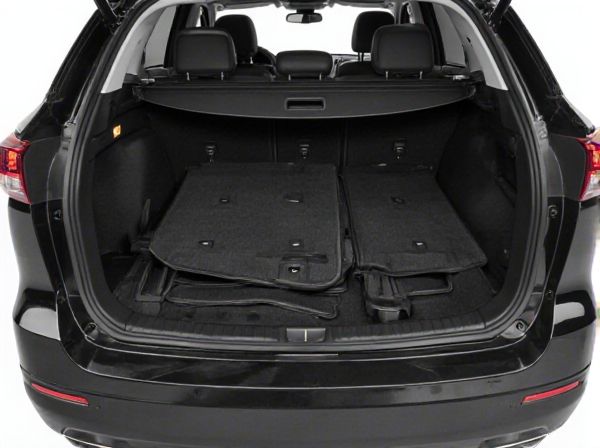
Photo illustration: Split-Folding Rear Seats vs One-Piece Folding
Split-folding rear seats allow you to fold down sections independently, enhancing flexibility for combining passengers and cargo. One-piece folding seats fold down entirely, offering a flat surface but less adaptability for mixed seating and storage needs. Choosing split-folding seats maximizes convenience when you need to transport varied loads without sacrificing passenger space.
Table of Comparison
| Feature | Split-Folding Rear Seats | One-Piece Folding |
|---|---|---|
| Flexibility | Allows partial seat folding for varied cargo and passenger combination | Entire seat folds down, reducing passenger and cargo setup options |
| Cargo Space | Optimizes space with segmented folding to accommodate larger items | Provides maximum flat cargo area when folded, limited to all-or-nothing use |
| User Convenience | Enhanced adaptability for mixed cargo and seating needs | Simpler mechanism, but less versatile for carrying passengers with cargo |
| Common Use Cases | Ideal for daily use requiring flexible passenger and trunk arrangements | Best for vehicles prioritizing maximum cargo space when seats are not needed |
Introduction to Rear Seat Folding Mechanisms
Split-folding rear seats offer enhanced versatility by allowing independent folding of seat sections, enabling a combination of passenger seating and cargo space. One-piece folding seats provide a simpler design where the entire rear seat folds down as a single unit, maximizing flat cargo area quickly but limiting seat configuration. These mechanisms directly impact vehicle functionality, passenger comfort, and the adaptability of interior space for different needs.
What Are Split-Folding Rear Seats?
Split-folding rear seats feature two or more independently adjustable sections, allowing passengers to fold down part of the rear seat while keeping the other section upright. This design maximizes cargo flexibility, making it easier to transport bulky items without sacrificing passenger space. Vehicles equipped with split-folding rear seats often enhance usability for both everyday commutes and road trips by optimizing interior space management.
Understanding One-Piece Folding Rear Seats
One-piece folding rear seats provide a uniform flat surface when folded, maximizing cargo space for larger items without gaps between sections. Unlike split-folding seats that allow selective folding for passengers and cargo flexibility, one-piece seats prioritize simplicity and maximum load area. This design is ideal for users frequently transporting bulky objects, offering a straightforward approach to expanding the rear storage capacity.
Key Differences Between Split-Folding and One-Piece Seats
Split-folding rear seats offer enhanced versatility by allowing individual sections to fold independently, enabling a customizable balance between passenger seating and cargo space. One-piece folding seats, in contrast, fold down as a single unit, providing a simpler design but less flexibility for partial cargo expansion. The key difference lies in split-folding seats supporting varied configurations for mixed loads, while one-piece seats prioritize straightforward, uniform folding.
Flexibility and Cargo Space Advantages
Split-folding rear seats offer enhanced flexibility by allowing independent folding of sections, enabling a combination of passenger seating and expanded cargo space tailored to specific needs. This configuration maximizes usability for transporting longer items on one side while accommodating passengers on the other, significantly improving versatility. In contrast, one-piece folding seats provide a simpler design but limit adaptability, as the entire rear seat must be folded down, reducing the ability to balance passenger and cargo requirements.
Passenger Comfort and Accessibility
Split-folding rear seats enhance passenger comfort by allowing individualized adjustment, accommodating varied passenger and cargo needs without compromising space. One-piece folding seats typically provide a flat load floor but limit flexibility, reducing accessibility for rear passengers when the seat is folded. Prioritizing split-folding configurations improves both comfort and ease of access in modern vehicles.
Practical Scenarios: Which Folding Option Wins?
Split-folding rear seats offer enhanced versatility by allowing passengers to fold down individual sections, accommodating both cargo and passengers simultaneously in practical scenarios such as grocery shopping or transporting sports gear. One-piece folding seats maximize cargo space quickly but limit flexibility when needing to carry a mix of passengers and bulky items, making them less ideal for day-to-day varied needs. In real-world use, split-folding seats win for families and active lifestyles due to their adaptable configuration and optimized space management.
Safety Considerations and Child Seat Compatibility
Split-folding rear seats offer enhanced safety by allowing drivers to keep one side upright to securely mount child seats while folding the other side for cargo, preserving seatbelt and anchor integrity. One-piece folding seats can compromise child seat stability by requiring the entire rear seat to fold down, potentially disrupting the proper use of LATCH anchors and seat belts. Ensuring child seat compatibility often favors split-folding designs, which maintain rigid support structures and prevent shifting during vehicle movement.
Impact on Vehicle Resale Value
Split-folding rear seats enhance vehicle resale value by offering versatile cargo and passenger configurations, appealing to a broader range of buyers. One-piece folding seats often limit flexibility, potentially reducing the vehicle's attractiveness in the used car market. Models equipped with split-folding seats, such as SUVs and crossovers, consistently show higher demand and better resale prices due to increased practicality.
Choosing the Right Rear Seat Folding Option
Split-folding rear seats offer versatile cargo management by allowing one or more sections to fold independently, ideal for accommodating passengers and varying cargo sizes simultaneously. One-piece folding seats provide a simpler, flat load floor but sacrifice flexibility, making them better suited for users frequently needing maximum uninterrupted cargo space. Choosing the right rear seat folding option depends on balancing passenger needs with cargo requirements, where split-folding seats excel in adaptability and one-piece seats emphasize straightforward utility.
 caratoz.com
caratoz.com